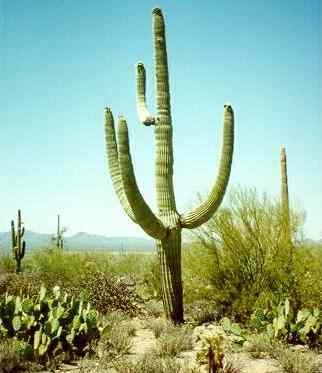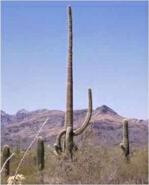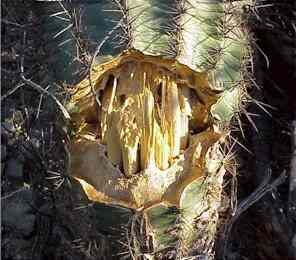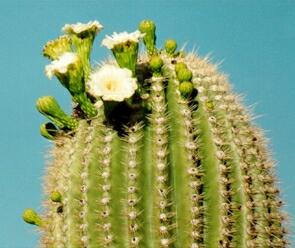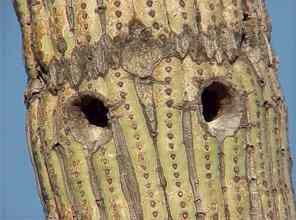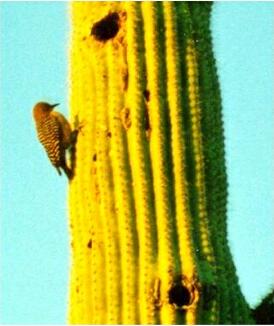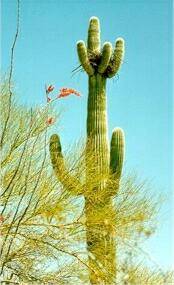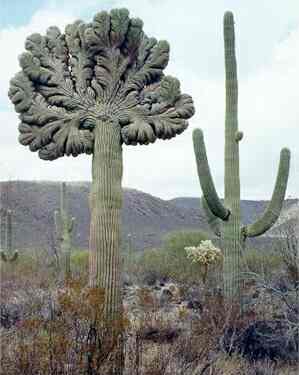|
[All images are clickable, for a larger version] The saguaro is the largest cactus in the USA, commonly reaching a height of 12 metres and an age of up to 200 years. It is one of the most characteristic plants of the Sonoran Desert, but actually has a quite limited geographical range, centred on southern Arizona and extending into western Sonora (Mexico). Within its range it can be extremely abundant, forming thick forests among desert trees and shrubs. It is particularly common in the Arizona Upland subdivision of the Sonoran Desert, around Tucson and Phoenix. One of the principal reasons for this is that the saguaro requires a reasonable amount of water - the annual precipitation averages -- cm in this region - and is fairly tolerant of frosts. Further south it is replaced by other large columnar cacti, such as the cardon, which are intolerant of frost. Further north it is limited by severe frosts. And in the regions of lower elevation to the west it is limited by drought.
The images above show that the saguaro can be a dominant feature of the landscape. But it almost always is accompanied by a high concentration of desert trees and subtrees, all of these being supported by the relatively high rainfall which occurs twice each year - in spring and in autumn. These trees act as "nurse plants" to the developing seedlings, which grow extremely slowly in their early years (see table below). The protection of a nurse plant helps to prevent the seedlings from being eaten by animals, and also provides shade and a more humus-rich, moisture-retentive soil in which the seedlings can develop.
Saguaros remain vulnerable to environmental damage throughout their lives. In particular, they can be blown down or broken by storm-force gusts of wind (see images below). They also can be damaged by lightning and by frosts in exceptionally cold years. Frost damage is probably responsible for the "sagging" and tapering of major branches, often seen near the edges of the saguaro's natural range.
The main stems of saguaros are supported by woody ribs, on the outside of which is a thick cortex of succulent, water-holding tissue and a thick epidermis to prevent water loss. The ribs of the stem are heavily spined, with a characteristic pattern of spines arising from each areole. Saguaros flower in spring, producing many buds near the tops of the stem and main branches. The bell-shaped flowers are about 8-10 cm wide, and are visited by bats, bees and doves. When pollinated, they give rise to succulent fruits, each about 8 cm long, which split open to reveal a red, juicy pulp containing up to 2000 small, black seeds. These fruits and seeds are eaten readily by many birds, mammals and insects. Seed dispersal is achieved mainly by birds (Gila woodpecker, white-winged doves, house finches), which each the pulp and deposit the seeds in their faeces. The tendency of these birds to perch (and defaecate) on the branches of trees helps to ensure that the seeds are deposited at the base of nurse plants. The seeds germinate rapidly (about 5 days) in response to late-summer rains, but only a very small fraction ever give rise to seedlings that survive the early years. Long-nosed bats also feed on the fruits, but they defaecate while flying or in their roosts, so they are thought to be of little significance in regenerating seedlings.
For many years it has been assumed that bats are the major pollinators of saguaros, because the flowers have all the features characteristic of bat pollination - nocturnal opening of the buds (although they remain open through to midday), heavy scent, copious nectar, etc. However, studies in which individual flowers were caged to exclude different types of pollinators in either night or daytime suggest that bees may be the more important pollinators - at least in some study sites. Even so, two species of bat that migrate annually from Mexico into Arizona (the lesser long-nosed bat and Mexican long-tongued bat) depend heavily on the flowers of saguaros, cardons and organpipe cactus to supply the protein (from pollen) and sugars (from nectar) that they require during their northwards migration. Saguaros provide habitat for several animals. The most conspicuous of these is the Gila woodpecker, which creates many of the nest holes seen in mature saguaro stems. Each year the woodpecker creates a new nest hole, and the previous one is then occupied by insects, lizards or occasionally by the ferruginous pygmy owl. The gilded flicker also produces nest holes in saguaros. Occasionally, the major branches of saguaros can have large twig-nests of hawks such as the red-tailed hawk or the Harris hawk. "Monstrose" growth Saguaros can occasionally develop in a grossly distorted way, termed mostrose growth. This form of growth is familiar to many people who collect cacti, because commercial nurseries purposefully create this growth pattern for decorative effect, by damaging the apical mersitem of the plants. One spectacular natural example is shown in the image below. In this case the damage might have been caused by frost but seems more likely to have been caused by an insect or other factor that disrupted the meristem, because the nearby plant is of similar age and has not been damaged. For whatever reason, the interesting point is that the disruption is permanent and has been perpetuated in all the subsequent growth. Another example of this monstrose growth can be seen in cardon.
|
|||||||||||||||||||||||||||||||
